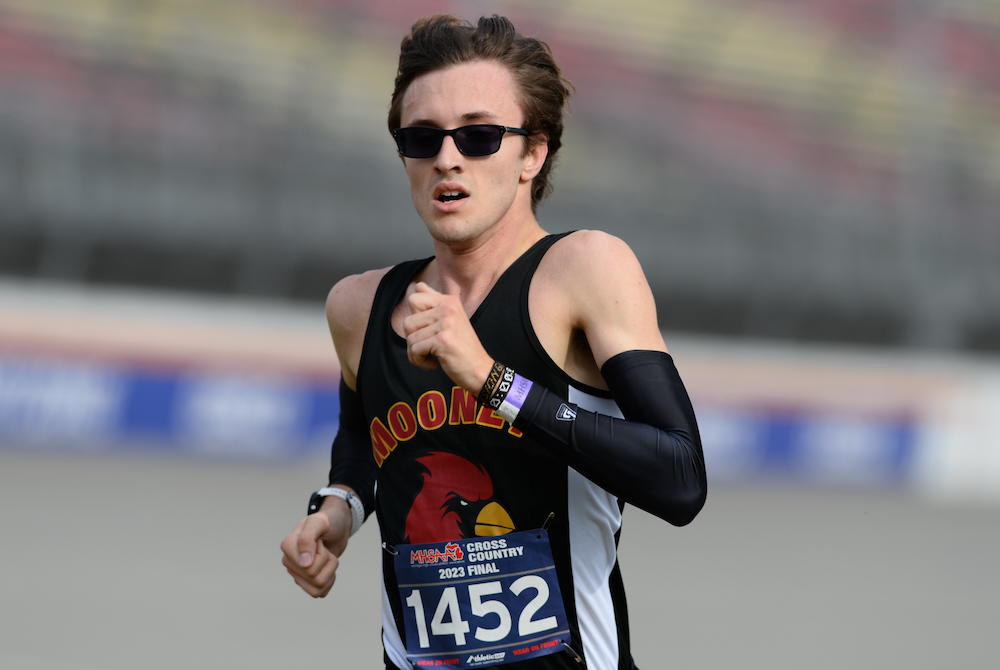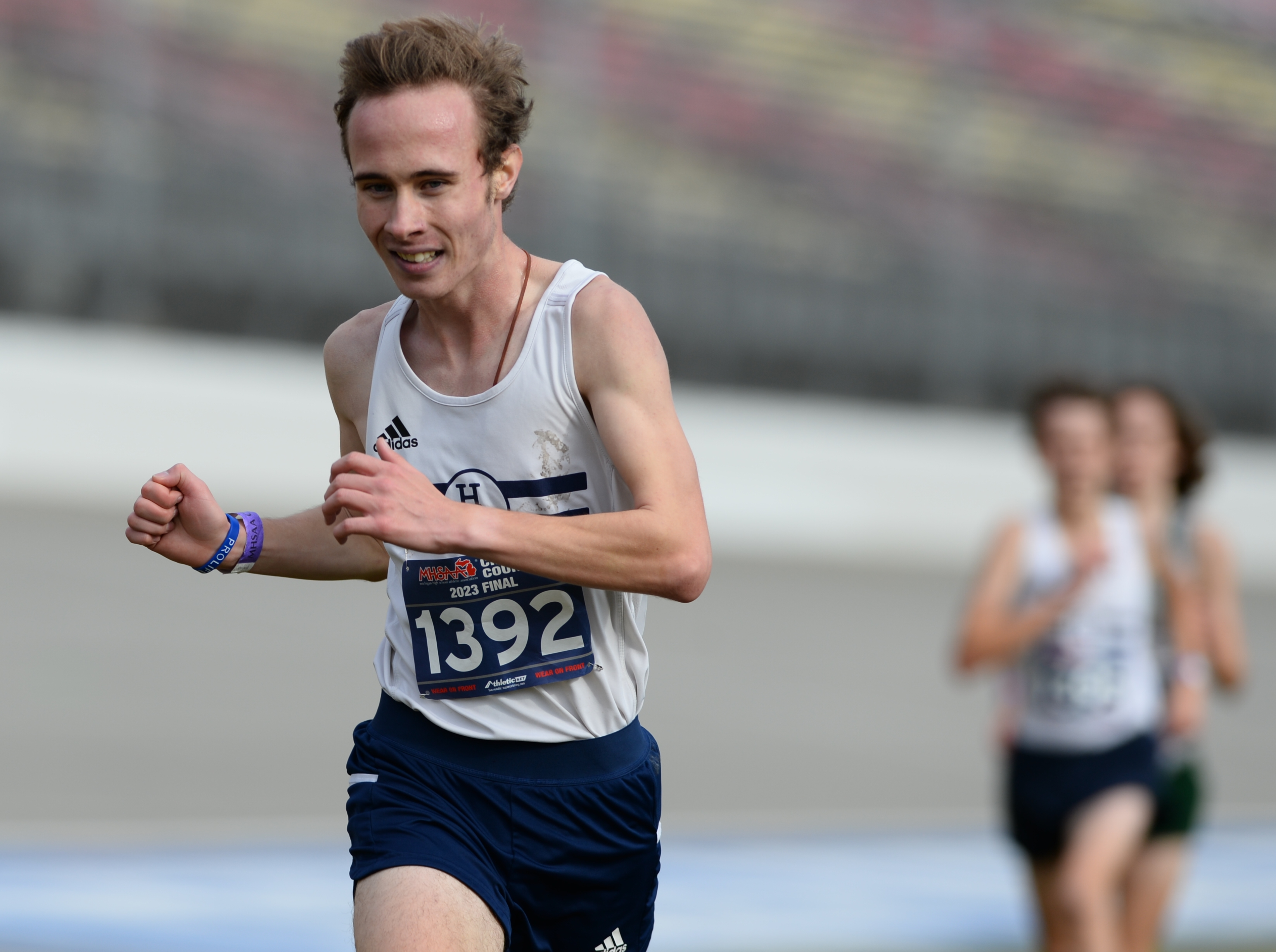
MHSAA Vault: MIS Rose to Challenges to Host 2020 LP Finals
By
Rob Kaminski
MHSAA benchmarks editor
November 12, 2021
The “MHSAA Vault” features stories from past publications and other documents in the MHSAA Library. This issue takes a look at the MHSAA Cross Country Finals at Michigan International Speedway, which celebrated 25 years in 2020 – although it was an event that nearly didn’t happen last fall …
In 1996, the MHSAA and Michigan International Speedway began a partnership the changed the course of the Lower Peninsula Cross Country Finals – quite literally.
The land in and around the track at Brooklyn would host the Finals for all classes of runners in one place on one day, an annual festival of nearly 2,000 runners competing for the MHSAA’s top honors.
Even skeptics – and there were several among running purists who thought the course was too flat, for example – can’t deny the results.
Finals attendance nearly doubled in that first year, and crowds in excess of 10,000 have enjoyed a day of racing several times, including a record 12,153 in 2011.
Enthusiastic crowds were the norm in recent years, with 11,232 in 2017, and nearly 11,000 in 2018 (10,989) and 2019 (10,873).
In fact, attendance failed to reach at least 8,000 only twice since the move to MIS.
Of course, last year was an exception, when attendance was limited to 1,000 spectators per session due to the COVID-19 Pandemic. Fans also were restricted to the grandstands rather than following the action throughout locations on the course.
To reduce the number of runners in each race, the event was spread over two days, with each Division being run in two separate “sections” with times then combined at the end to determine team and individual champions.
While not ideal, the end result was another year of fantastic efforts at MIS – both from student-athletes and those behind the scenes.
“Even at the last hour, less than a week ahead of the Finals, we were closer to not having the Finals than we were to having them,” said MHSAA Assistant Director Cody Inglis, who coordinates the cross country postseason. “Rumors and challenges of mandated shutdowns, testing and other requirements were being discussed and caused a lot of unknowns. Even at the Regional level, we had schools, Regional courses and hosts shutting down their facilities; we had to relocate four Regionals 48 hours prior to race times. That scenario just could not happen at the Finals level where far more runners and much more travel would be involved.”
Among the many last-minute hurdles was the edict from NASCAR – which owns MIS – that all persons on site be temperature checked upon entry. That meant securing thermometers that were easy to operate in short order, along with personnel necessary to conduct the readings.
The attendance limitations certainly helped to implement the temperature screening, but brought their own issues.
“Limiting spectators was not a popular decision, but it really was the only way to have a race,” Inglis said. “We were taking direction and working with policies and protocols from the MDHHS, the Governor’s office, Lenawee County Health Department, MIS and NASCAR.”
Part of the solution was to utilize the grandstands as a “barrier” between participants and spectators. The reduced number of fans were dispersed over thousands of seats while still allowing them the chance to watch their student-athletes compete.
“It wasn’t the same, it wasn’t easy or perfect, but it was what we had to do to have a race,” Inglis said. “Separating the Finals into two days and different sections also allowed us to spread out the event and limit the number of people on site at any one time. This was a key part of the plan and worked well even though it separated races within a Division.”
The MHSAA, MIS and the cross country community never lost focus of the main goal: a culmination of the season for the student-athletes, who deserved something last year more than ever. And, more than ever, MIS once again displayed its advantage as a venue that could adapt to the fluid nature of the times to pull off the event.
“There were some thoughts of using four different sites, but as we learned during the Regionals, the climate of things was so tenuous from one area of the state to another that we couldn’t be 100-percent certain that there wouldn’t again be last-minute cancelations,” Inglis said. “MIS was wonderful to work and collaborate with, and was the best option to get it done. It was never mentioned once publicly about the possibility of not having the Finals – only how we could best do it under uncharted conditions.”
The moving parts and ever-changing scenarios created more complexity than ever in finalizing a season, but every decision was made with the complete desire to conduct the Finals as close to normal as possible.
“I firmly believe that a finish to the season, no matter the differences in race formatting and fan experience, was something everyone would have taken when the season began in August,” Inglis said.
Indeed, the finish line in Year 25 at MIS might have been the most gratifying of them all.

Cardinal Mooney's Lenn, Hillsdale Academy Run to Division 4 Championships
November 4, 2023
BROOKLYN — Among the T-shirts cross country runners enjoy wearing — besides “our sport is your sport’s punishment” — are those that emphasize the importance of summer training.
“Summer miles bring fall smiles” and “Medals are earned in the summer and picked up in the fall” are among the favorites.
Marine City Cardinal Mooney senior Tyler Lenn wasn’t smiling much during the summer, because he was unable to log those all-important miles required for building an aerobic base.
He ran through injuries during track & field season before the pain became too much. He was dealing with a stress fracture, Achilles’ tendinitis and calf strains in both legs.
“Mentally, for me, it was not where I wanted to be,” Lenn said. “I don’t think anybody would want to be in that position. At the same time, there’s nothing I could have really changed about it. I made the most out of the situation, and I guess I showed that today.”
 Lenn was all smiles Saturday at Michigan International Speedway, standing atop the podium after winning the MHSAA Lower Peninsula Division 4 individual championship.
Lenn was all smiles Saturday at Michigan International Speedway, standing atop the podium after winning the MHSAA Lower Peninsula Division 4 individual championship.
Lenn posted a personal-best time of 15:49.0 to win by 12 seconds over Owen Patton of Vestaburg.
It was the culmination of a rocky season that began to turn around Oct. 20 when he won his league meet in 16:02.1. He ran 18:35.1 17 days earlier and 17:09.3 in his previous meet.
“I was like, ‘OK, I feel like I have a little bit of confidence in my body again,’” Lenn said. “Throughout the season, it was really rough. I would just fall apart in some races where I would trip and tweak the ankle and I would fall apart in the race mentally.”
Patton held a slight lead at the mile and two mile before Lenn laid down the hammer in the final mile.
“I think I made the right move,” Lenn said. “I just fought for positioning in the first 400 (meters), kind of held myself back a little bit to save for the end.”
Top-ranked Hillsdale Academy won the team championship, scoring 129 points to win by 70 ahead of Holland Calvary. It was the second MHSAA championship for Hillsdale Academy, which won in 2021.
Senior Thomas Holm was fourth, junior Reece Poole was fifth, sophomore Grayson Rorick was 20th, freshman Ryan Miller was 76th and sophomore Harry Lindsley was 80th for Hillsdale Academy.
PHOTOS (Top) Cardinal Mooney’s Tyler Lenn leads through the stretch of the Division 4 Final on Saturday at MIS. (Middle) Thomas Holm pushes toward a fourth-place finish that led Hillsdale Academy to a team title. (Photos by Dave McCauley/RunMichigan.com.)

